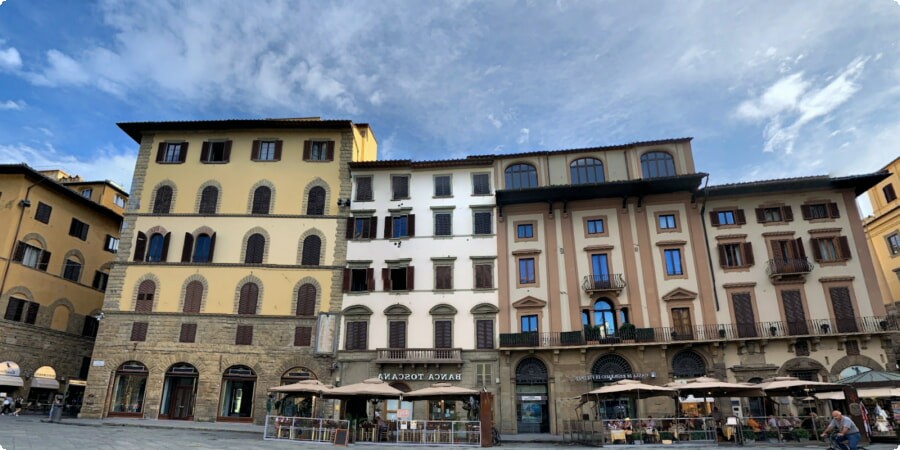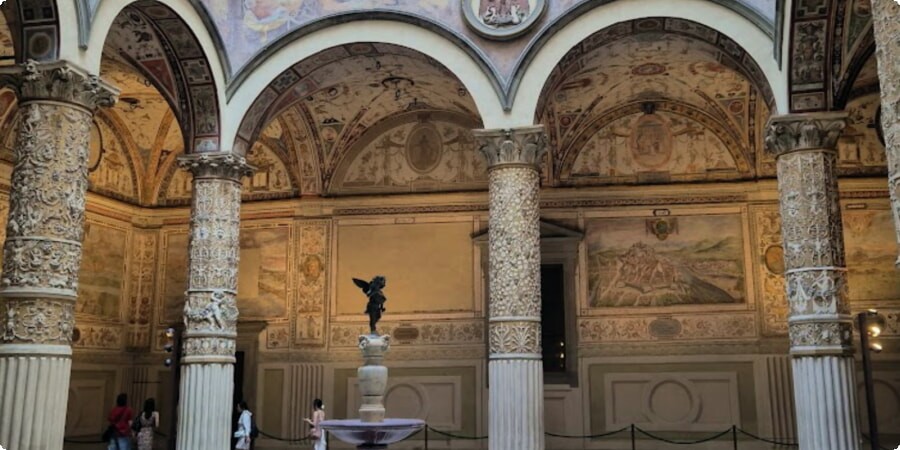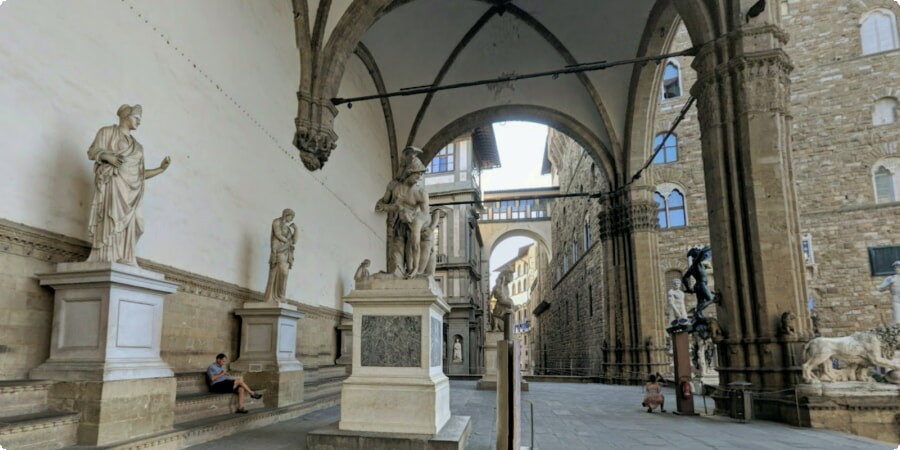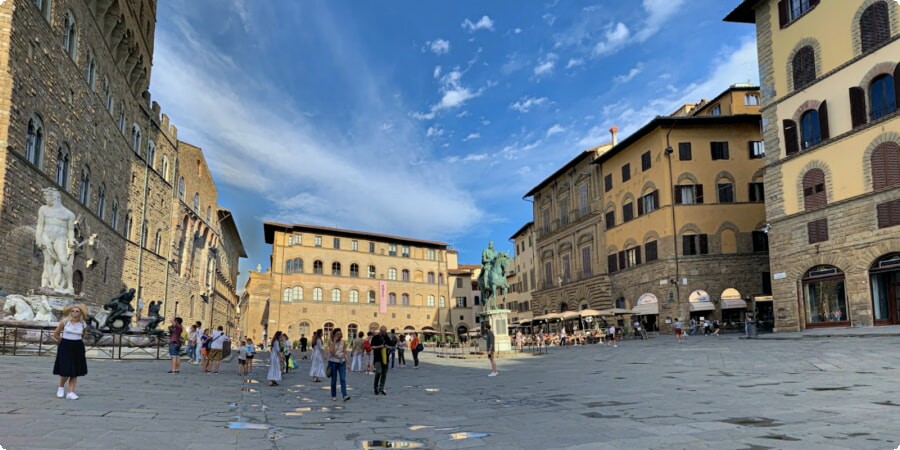Palazzo Vecchio: Exploring Florence's Historic City Hall
Nestled in the heart of Florence, the Palazzo Vecchio stands as a testament to the city's rich history and architectural grandeur. As Florence’s town hall, this majestic building has been at the center of civic life for centuries. Its impressive facade, adorned with the Medici coat of arms and a replica of Michelangelo's David, hints at the storied past and the power once wielded within these walls.
Originally constructed in the late 13th century, Palazzo Vecchio was not merely a seat of municipal governance but also a symbol of the Florentine Republic's power and pride. Over time, it has witnessed numerous historical events, from political intrigues to artistic flourishes. Today, it serves as both a historical monument and an active cultural hub, reflecting Florence's enduring legacy.
A Historical Overview: From Medieval Fortress to Civic Center
The origins of Palazzo Vecchio trace back to 1299 when the Florentine government commissioned its construction as a defensive fortress and the seat of the city’s magistrates. Designed by Arnolfo di Cambio, the building was intended to convey the strength and authority of the Florentine Republic. Its sturdy, fortress-like appearance, with its imposing walls and defensive towers, was both a statement of power and a practical safeguard against potential threats.
Throughout the centuries, Palazzo Vecchio evolved to meet the changing needs of Florence. During the 14th and 15th centuries, it became a center of political activity and intrigue, housing the ruling bodies of the city. The building’s role expanded during the Renaissance when it became a symbol of Florence's artistic and political prominence. Notably, it served as the seat of the Medici family, who made significant modifications and additions, including the famous Salone dei Cinquecento.
In the 19th century, following the unification of Italy, Palazzo Vecchio underwent restoration to preserve its historical integrity while adapting to its role as the city hall of modern Florence. Today, it stands not only as a historic building but as a vibrant cultural and civic center, hosting events, exhibitions, and official ceremonies.

Architectural Marvels: The Design and Structure of Palazzo Vecchio
The architectural splendor of Palazzo Vecchio is evident in its commanding presence and intricate design. Its robust, medieval architecture features a distinctive crenellated tower that rises 94 meters above the city. This tower, often referred to as the Torre d'Arnolfo, served both as a lookout point and a symbol of civic authority.
The building’s facade is characterized by its large stone blocks and minimalist, yet imposing, design. The exterior is adorned with the Medici family’s coat of arms and several sculptures, including a replica of Michelangelo's David, which was originally placed here to celebrate the strength of Florence’s democratic ideals.
Inside, Palazzo Vecchio reveals its architectural richness through its grand halls and ornate rooms. The Salone dei Cinquecento (Hall of the Five Hundred) is particularly noteworthy, with its vast space and stunning frescoes by Giorgio Vasari. The hall was designed to accommodate the Grand Council of Florence and is a prime example of Renaissance grandeur.
The interior also features a series of elegant rooms and chambers, each showcasing the artistic and architectural innovations of the time. From the richly decorated Studio di Francesco I to the Cappella dei Priori, the building’s rooms are adorned with elaborate frescoes, intricate woodwork, and classical sculptures.
Exploring Florence
To fully appreciate Palazzo Vecchio and its surroundings, consider renting a car to explore Florence at your own pace. You can easily book a rental car through Cars Scanner to enhance your travel experience in this historic city. With a car, you’ll have the freedom to visit not only Palazzo Vecchio but also other iconic landmarks and hidden gems in Florence.

The Salone dei Cinquecento: Florence's Grand Council Hall
One of the most awe-inspiring spaces within Palazzo Vecchio is the Salone dei Cinquecento (Hall of the Five Hundred). This grand hall was originally designed to accommodate the Grand Council of Florence, which was composed of 500 members. Its immense size and architectural splendor reflect the significance of its function in the city's political life.
The Salone dei Cinquecento is renowned for its impressive frescoes and decorations. The ceiling is adorned with magnificent works by Giorgio Vasari, depicting the allegories of Florence’s triumphs and virtues. The hall’s walls are lined with statues of important figures from Florence’s history, adding to the room’s grandeur.
The hall also features a series of tapestries and artworks that capture various aspects of Florence’s historical and cultural heritage. The overall design of the room, with its high vaulted ceiling and vast space, was intended to project the authority and prestige of the Florentine Republic. Today, it remains one of the most iconic rooms in the Palazzo, often used for official events and ceremonies.
Art and Decoration: The Masterpieces Within Palazzo Vecchio
Palazzo Vecchio is not only a historical and architectural marvel but also a treasure trove of art and decoration. The building houses a rich collection of artworks and sculptures that reflect Florence’s artistic heritage and the grandeur of the Renaissance.
One of the highlights is Donatello’s Judith and Holofernes, an iconic bronze sculpture located in the courtyard of Palazzo Vecchio. This work exemplifies Donatello’s masterful use of bronze and his innovative approach to classical themes. Another notable artwork is Michelangelo's David, which, although now a replica, originally stood here as a symbol of the city’s strength and independence.
The building’s interior is adorned with intricate frescoes, elaborate woodwork, and classical sculptures that showcase the artistic achievements of the Renaissance. The richly decorated Cappella dei Priori (Priori Chapel), for example, features exquisite frescoes and a beautifully crafted altar. Each room within Palazzo Vecchio offers a glimpse into the artistic and cultural richness of Florence during the Renaissance.

Exploring the Secret Rooms and Hidden Corners
One of the fascinating aspects of Palazzo Vecchio is its hidden rooms and secret spaces, which add an element of mystery and intrigue to the building. These lesser-known areas offer a glimpse into the private and political lives of those who once inhabited the Palazzo.
Among the hidden spaces is the Stanza della Segnatura (Room of the Signoria), which was used by the city’s magistrates for important meetings. The room features concealed compartments and secret passages that were used for discreet communication and storage.
Another intriguing space is the Underground Chambers, which were once used as secret storage areas and escape routes. These chambers are accessible through guided tours and offer a unique perspective on the building’s history.
For those interested in exploring these hidden aspects of Palazzo Vecchio, guided tours are available that provide access to some of these secret rooms. These tours offer a deeper understanding of the building’s historical significance and the lives of its past inhabitants.
Traveling Around Florence
To explore Palazzo Vecchio and its hidden corners, consider renting a car to navigate Florence and its surroundings. Booking a rental car through Cars Scanner can enhance your travel experience, allowing you to easily access various landmarks and attractions in and around Florence.
Palazzo Vecchio Today: A Cultural and Civic Hub
Today, Palazzo Vecchio continues to be a vibrant center of civic and cultural life in Florence. The building not only serves as the city's town hall but also hosts a variety of events and cultural activities throughout the year. It remains a symbol of Florence's rich history and its ongoing commitment to preserving and celebrating its heritage.
The Palazzo hosts numerous official ceremonies, including civic receptions and municipal meetings. Additionally, it functions as a museum, offering visitors a chance to explore its historical and artistic treasures. Special exhibitions, art shows, and cultural events are regularly held, making Palazzo Vecchio a dynamic and engaging destination for both locals and tourists.
The building's central location in Piazza della Signoria also makes it a focal point for Florence's public life. Its continued role as a civic and cultural hub ensures that Palazzo Vecchio remains at the heart of the city's social and political activities.

Visitor Experience: Practical Tips and Recommendations
Visiting Palazzo Vecchio is a must for anyone interested in Florence’s history and architecture. To make the most of your visit, here are some practical tips and recommendations:
-
Opening Hours and Admission: Palazzo Vecchio is typically open to the public every day except Mondays. Be sure to check the official website for the most current hours and admission fees before planning your visit.
-
Guided Tours: To fully appreciate the historical and artistic significance of Palazzo Vecchio, consider joining a guided tour. These tours offer insightful commentary and access to areas that might not be open to the general public.
-
Audio Guides: For a self-guided experience, audio guides are available and provide detailed information about the building’s history, art, and architecture.
-
Dress Code: While there is no strict dress code, it’s advisable to dress respectfully, as Palazzo Vecchio is a historic and active civic building.
-
Accessibility: The building is accessible to visitors with mobility issues, though some areas may be challenging to navigate. Check the accessibility options in advance to ensure a comfortable visit.
Surrounding Attractions: What to See Nearby
Palazzo Vecchio is ideally situated in Piazza della Signoria, which is home to several other notable attractions. Here are some nearby landmarks and points of interest to explore during your visit:
-
Uffizi Gallery: Just a short walk from Palazzo Vecchio, the Uffizi Gallery houses one of the most important collections of Renaissance art in the world. It is a must-visit for art enthusiasts.
-
Ponte Vecchio: This historic bridge, famous for its shops and stunning views of the Arno River, is a short stroll from Palazzo Vecchio. It offers a picturesque and romantic experience.
-
Florence Cathedral (Duomo): A bit further but still within walking distance, the Florence Cathedral is renowned for its striking dome designed by Brunelleschi and its impressive façade.
-
Piazza della Repubblica: A lively square with shops, cafes, and historic significance, perfect for a leisurely break.
Exploring these nearby attractions will enhance your visit to Palazzo Vecchio and give you a fuller experience of Florence’s rich cultural and historical tapestry.